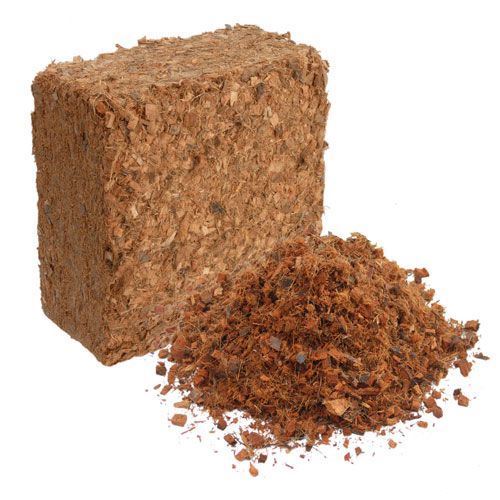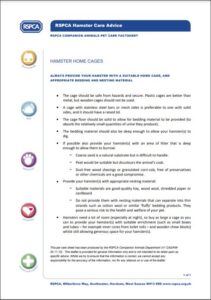Safe & Unsafe Hamster Bedding
Hamster bedding is one of the most important things in your hamster’s cage. To encourage natural behaviour, it is best to have plenty of bedding so that your hamster can make a burrow just like they would in the wild. Popular choices such as Carefresh and Kaytee have a tissue clump texture and are good types for holding up the structure of a burrow, your hamster will dig into them to make tunnels and chambers. Other textures can be mixed in to help hold up the structure of a burrow, such as Soft Hay and safe types of wood such as Aspen which is safe to use as it doesn’t produce dust. Sections of added enrichment such as Coco husks and Beech chips will also provide a more varied environment.
The picture below shows what a hamsters burrow looks like in the wild.
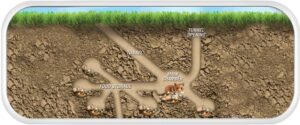
Thanks to our friends at Hamster Society Singapore – The Art of Hamster Burrows
The bedding also known as substrate has multiple purposes:
- It is the ground the hamster walks on and also the ground they will dig into to make a burrow and a chamber to sleep.
- The bedding serves as an absorbent material for urine and the ammonia smell.
- To remove smell Spot Cleaning of soiled bedding is recommended.
- The bedding protects your hamster from hot or cold.
- Different textures will provide enrichment.
You Should Give Your Hamster a Section of Deep Bedding
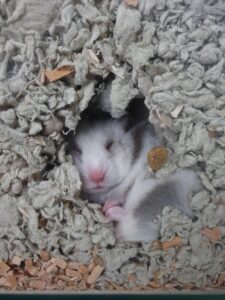
Research shows that giving your hamster the ability to burrow results in a far happier and less stressed hamster. Research on Bedding depth has shown “Hamsters kept with 10 cm deep bedding showed significantly more wire-gnawing and a higher running wheel activity than the hamsters in the other groups. In 80 cm deep bedding wire-gnawing was never observed.”
The RSPCA say: “In the wild hamsters are extremely good diggers and construct deep, dark, underground burrows so, if possible, give your hamster a thick layer of litter/bedding in which to dig and burrow”
A hamster could start to burrow in at least 6 inches of bedding but a section of 10 inches (25cm) is much more suitable as the hamster can make a deeper burrow like they would have done in the wild, it is also a way to make them feel safe and warm in their environment.
Safe Hamster Bedding
- Paper Based – i.e. Carefresh, Kaytee, Teabag, Fitch, Megazorb, Unscented Toilet Paper
- Aspen Bedding
- Hemp Bedding
- Spruce Bedding – i.e. Chipsi Classic
- Soft Hay – i.e. Timothy Hay, Orchard Grass
- Enrichment – i.e. Beech Chips, Coco Chips, Soil
There are many different types of bedding out there to choose from, but not all hamster bedding is safe! Sometimes the packaging will say it is safe when it is not, even if it’s sold in a major store! So check out our list of unsafe bedding at the bottom half of this page.
Paper Based Bedding
Paper based bedding is generally recommended as being the safest and best option. Popular types look like clumps of tissue and this type of bedding will hold up borrows and will keep the hamster warm. Paper bedding can come in different colours and this is a bonus to some hamster owners who like to make their cage themed. Paper will need to be fluffed up when it’s taken out of the packet and when the hamster walks on it, as it will start to compact together.
Here are some examples of paper bedding on the market:
Carefresh
Kaytee
Teabag Paper Bedding
Fitch
Good value for money if you need large quantities of bedding
Megazorb
Megazorb bedding is made out of virgin wood pulp and goes through the same treatment process as paper. It will be washed and cleansed getting rid of all toxic phenols. Marketed for horses, you can get a good value big bag which is great for the quantity that you need for a big enclosure.

Tiffany uses a mix of Plain Paper Bedding and Aspen
In the unboxing video you will see that Tiffany uses the subscription service from Small Pet Select because she loves to use a mix of their Paper and Aspen bedding.
Unfortunately Small Pet Select also make a lavender bedding which we strongly advise against, please refer to our Scented Bedding Dangers page.
Unscented Toilet Paper
Simply tearing up pieces of regular toilet roll can provide a surprising amount of safe hamster bedding. Toilet paper is designed to breakdown in water and it’s best to buy the cheapest type of toilet paper as it will break down more easily if accidentally ingested. It is important to also use a non scented plain toilet roll as any perfume smell will at the least make your hamster feel like they are constantly stuck in a lift with some one spraying perfume or at a worst case scented hamster bedding has been known to cause deaths. The great news is with toilet roll it’s best to stick to the cheapest most basic type. Even experienced hamster keepers who use other types of paper based bedding like Carefresh or Fitch which are better types for burrowing, will still add some torn up toilet roll as an extra nesting material.
You can DIY your own Bedding using a Shredder!
Many people can be on a bit of a tight budget or cannot get hold of any bedding. There are a lot of nifty DIY bedding hacks on YouTube. For example, Ollie from “SomethingAnimal” makes paper bedding by putting Tissue Roll through a shredder machine.
Aspen Bedding
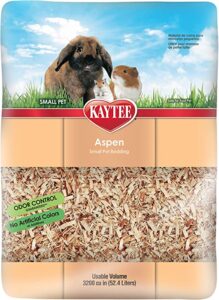
This type of bedding is a safe wooden based bedding also known as hardwood shavings, different to other types of wood (i.e. Sawdust) Aspen doesn’t produce harmful dust that could cause respiratory problems and irritate a hamsters eyes. The hamster community recommend Aspen and Spruce as being the only types of wood based bedding that is safe to use. Aspen will give another texture to the enclosure, it’s not great at holding up burrows on its own so another bedding such as paper bedding would need to be added to the enclosure. Aspen is a good absorbent for urine and can help with odor control. If your pet shop seems to not stock aspen check the reptile section as it is the same type that is often used in reptile enclosures.
Hemp Bedding
A great safe alternative to getting a similar texture to sawdust and doesn’t produce harmful dust. Similar to Aspen this isn’t good for burrowing on it’s own, so you will need to also add a Paper based bedding like Carefresh and that will hold up the structure of a tunnel and sleeping chamber. Aubiose Hemp Bedding is marketed towards horses so you get plenty of it, is actually ErinsAnimals favorite hamster substrate to use.
Spruce Bedding
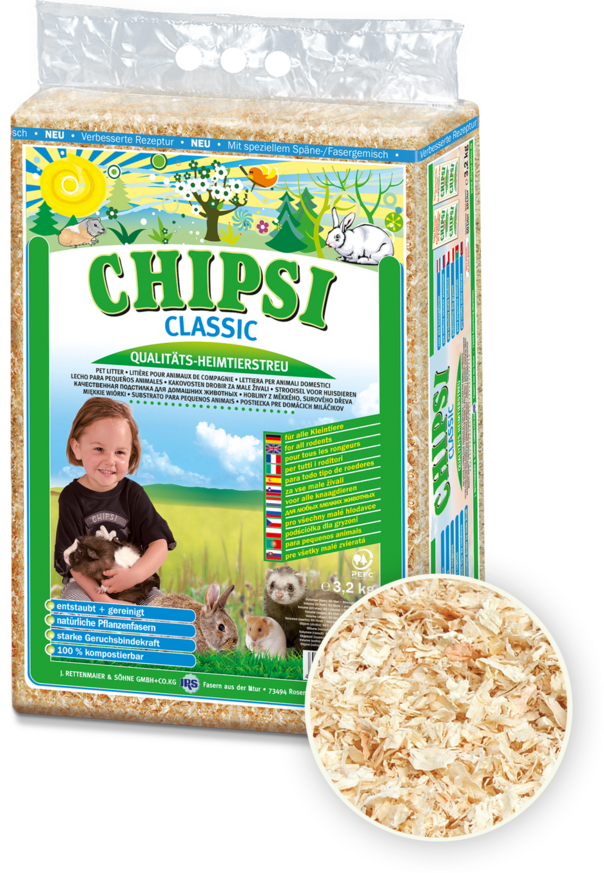
Spruce Bedding is a softwood but is equivalent to a hardwood in terms of phenols being at such a low level they are safe. Chipsi Classic is a mix of Spruce and Fir and is said to be around 70-75% Spruce which dilutes the phenols found in Fir. Furthermore, the wood is Kiln dried which helps dilute the phenols. For many years Chipsi Classic has proven to be a safe product for most hamsters. However, some hamsters may be allergic to all types of wood in general and then this type of bedding should not be used. Always look out for signs of respiratory issues such as laboured breathing, sneezing and coughing. Also, skin/eye irritation & fur loss. Although the bedding may not be the cause it’s good to use a process of elimination.
Soft Hay
Hay is great substrate to add to your hamsters enclosure, adding layers of hay to other types of bedding can help hold up structures of burrows. To avoid poke injurys to your hamster only soft types of hay are recommended. These types are more grass based and hamster safe types are known to be Timothy Hay, Orchard Grass, Alfalfa Hay, Botanical Hay, Oat Hay.
Enrichment
Beech Chips
Beech chips are a good enrichment for a hamster, you can use for a dig box, this will add another texture to their enclosure.
Coco Chips / Husks
Coco chips / husks are parts of the coconut shell, it’s a good enrichment for a hamster to dig and chew.
You Can Use Soil to Add Another Texture
Soil adds another sensory experience and helps to create a natural environment like in the wild. (WARNING – Don’t just go outside and collect soil from your garden it may be contaminated with harmful bugs that you can’t see.) Coco soil from a pet shop is the most common type of soil hamster keepers use. This can be found in a brick or loose and is one of the safest options. It would be best to put the soil in it’s own section of the enclosure for example in a dig box / area. Some hamsters have fun getting dirty and digging in it. Do not worry you can dust it off or they will clean themselves.
Unsafe Hamster Bedding
- Sawdust
- Pine
- Cedar
- Scented Bedding
- Fluffy Bedding
- Corn cob bedding
- Unknown wood bedding
Sawdust
Sawdust contains very fine wood shavings and this makes it very dusty. For years Pet Shops have been saying this is suitable and it has been commonly used. However it is now known that the dust from Sawdust can lead to respiratory infections in small animals. This is now widely discussed for example research centre SATRA say “very fine particles in sawdust can cause respiratory problems for all animals, especially for small ones such as guinea pigs and hamsters”. If constantly breathing in the small dust particles isn’t bad enough it is also thought that fine dust can irritate a hamsters eyes.
Blue Cross say “Most wood shavings or sawdust should be avoided as these can be bad for your hamster’s respiratory system and can become very smelly when urinated on (although aspen shavings can be used)”
(If you want a substrate with a wood texture for your enclosure, use Aspen or Hemp they are known to be safe as they don’t have the fine dust particles)
Pine/Cedar
There is Plicatic acid and other harmful chemicals that are found in cedar trees. Plicatic acid protects the tree from bugs and fungi by killing cells but it is all known to be toxic and an irritant for hamsters. Simarily, Pine trees contain Abietic acid which the OSHA has classified as a skin and respiratory irritant. For hamsters, Pine and Cedar can cause respiratory infections, allergic reactions and asthma. Our friends at Hamsters South Africa have made a page about the dangers of pine and cedar.
Scented Bedding
Scented Bedding can cause a respiratory infection and will irritate their nose and stress them out. Hamsters have very sensitive noses so scented bedding would be like if you were in a lift with someone constantly spraying strong smelling spray, it would start to irritate you and you will cough as it hits the back of your throat. Hamsters rely on their scent and adding a different scent will stress them out, this is why many hamster owners will put a bit of old bedding back into their cage, so that the hamster has his or her own smells and will feel safe and at home.
Fluffy Bedding
Fluffy Bedding for hamsters includes all types of bedding which are similar to cotton wool, cotton, kapok, bamboo fluff these may all be natural but that doesn’t mean they are safe. As well as an entanglement issue there is a respiratory issue with the material entering the lungs and an ingestion issue which can cause a fatal blockage. It is believed that the fluff gets stuck to the inside of a hamsters cheeks, and this is one way how it may become ingested. The Bluecross, Royal Veterinary College and The RSPCA say fluffy bedding is dangerous:
The RSPCA say:
“Do not provide them with nesting materials that can separate into thin strands such as cotton wool or similar ‘fluffy’ bedding products. They pose a serious risk to the health and welfare of your pet.”
rspca rodents hamsters/environment
PDSA Say:
“Fluffy beddings – such as cotton wool, kapok, and bamboo fluff, these are often marketed as safe for hamsters but can cause injuries by getting wrapped around their legs, and life-threatening gut blockages if ingested.”
Corn Cob Bedding
Corn cob bedding forms mould very easily for example if it becomes wet from water or urine, and bacteria then starts to form. It can also cause obesity and some hamsters are known to eat it. Corn cob bedding may also contain insect/parasite eggs which can also be harmful to a hamster.
Unknown Bedding
When bedding has no information on what type it is, it is best to stay clear of it as it could be any of the types of the bedding listed above.
© Copyright 2022 HamsterWelfare.com


